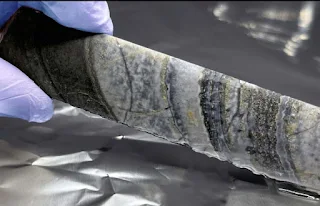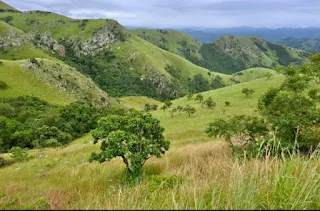Chemical analysis of rocks found in South Africa shows that ancient microorganisms sustained themselves in a variety of ways, adding to evidence for an early origin of life on Earth
 |
| A sample of chert rock containing what may be the remains of microorganisms that lived 3.4 billion years ago. (Credit: Dr. Manuel Reinhardt) |
As early as 3.4 billion years ago, life on Earth had formed diverse communities. Exceptionally preserved remains from the period reveal an ecosystem of microorganisms that sustained themselves in a range of ways.
The complexity of the ecosystem suggests life had already existed for hundreds of millions of years and began early in Earth’s history.
Manuel Reinhardt at the University of Göttingen in Germany and his colleagues studied rocks from the Buck Reef Chert, part of the Barberton Greenstone Belt in South Africa. The rocks are 3.42 billion years old and are thought to be the preserved remnants of the shallow seas around a chain of volcanic islands.
The layers of rock contain microscopic blobs of carbon-based matter, believed to be the remains of microorganisms that lived in these seas. Reinhardt and his group subjected this matter to a battery of analyses to determine its chemical makeup, which they used to infer what sort of metabolism these microorganisms had.
The team focused on the carbon itself. Carbon comes in several forms called isotopes, which are identical apart from the number of neutrons in the nucleus of the atom. The main two carbon isotopes are carbon-12 and carbon-13. Living things prefer to use carbon-12, so biological matter tends to have more carbon-12 and less carbon-13 than non-biological matter.
However, not all living things are equally good at preferentially absorbing carbon-12. That means the ratio between the two forms can provide clues about an organism’s metabolism.
Much of the material has a carbon signature that matches photosynthesis: the ability to use light energy to make sugar. This suggests there were enormous quantities of photosynthetic microbes living near the surface of the sea billions of years ago.
However, some of the blobs had less carbon-12. Photosynthetic organisms can’t achieve this, so Reinhardt says those microbes must have been feeding on a chemical called acetyl coenzyme A.
Other blobs had still lower levels of carbon-12, suggesting the microbes in them were making either methane or acetate as waste products, which other microbes were then feeding on.
It isn’t possible to tell if all the microbes were living in exactly the same place at the same time, says Reinhardt. The photosynthetic ones must have lived near the surface of the water, but the others may have lived in sediments on the seabed.
 |
| The Barberton Greenstone Belt of South Africa (Credit: Friedrich Von Horsten / Alamy) |
The research is “brilliant” and “really painstaking”, says Frances Westall at the French National Centre for Scientific Research in Orléans, who wasn’t involved in the study. “What I’m reading out of this is that early life was working very much similarly to life today.”
The study also adds to the evidence for an early origin of life on Earth, earlier than a crude reading of the fossil record might suggest.
The oldest widely accepted evidence for life is 3.5 billion years old, from Pilbara in Australia. Researchers have reported evidence of older fossils from 3.7 billion years ago or even earlier, but others say the evidence isn’t convincing in most of those cases.
“All the rocks older than about 3.5 billion years old, they are so badly metamorphosed,” says Westall. That means the oldest ecosystems we can see are rich communities like the one Reinhardt’s team studied. There must have been older and simpler versions, but we haven’t seen them because they aren’t preserved – at least not in ways we can currently detect. As a result, the earliest history of life remains unknown. “It’s very difficult to see the trend, simply because of a lack of well-preserved rocks,” says Westall.
What does seem clear is that life is significantly older than 3.5 billion years. “Personally, I think life emerged on Earth during the Hadean [eon], probably about 4.2, 4.1 billion years [ago],” says Westall.
Journal reference:
Precambrian Research DOI: 10.1016/j.precamres.2024.107289





0 Comments